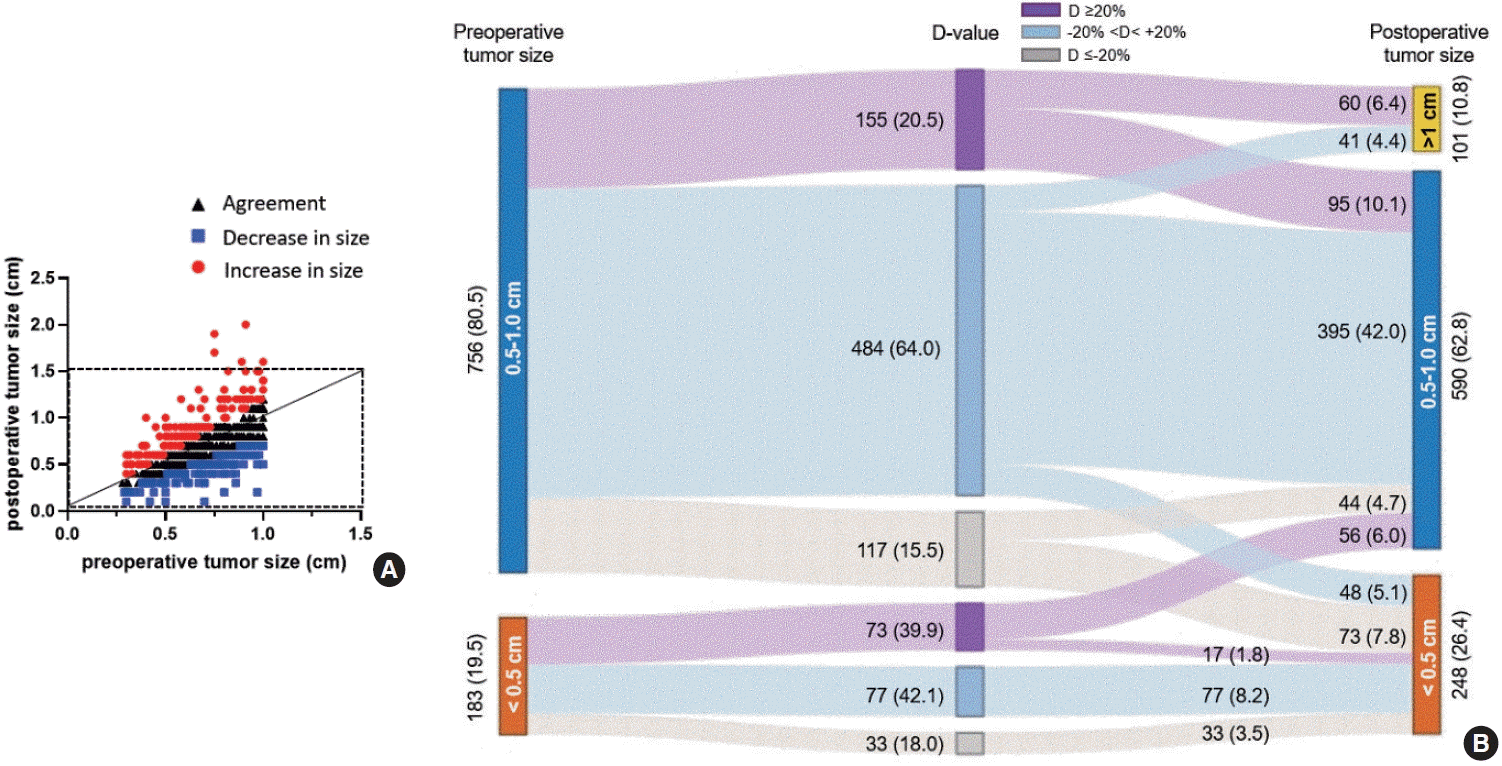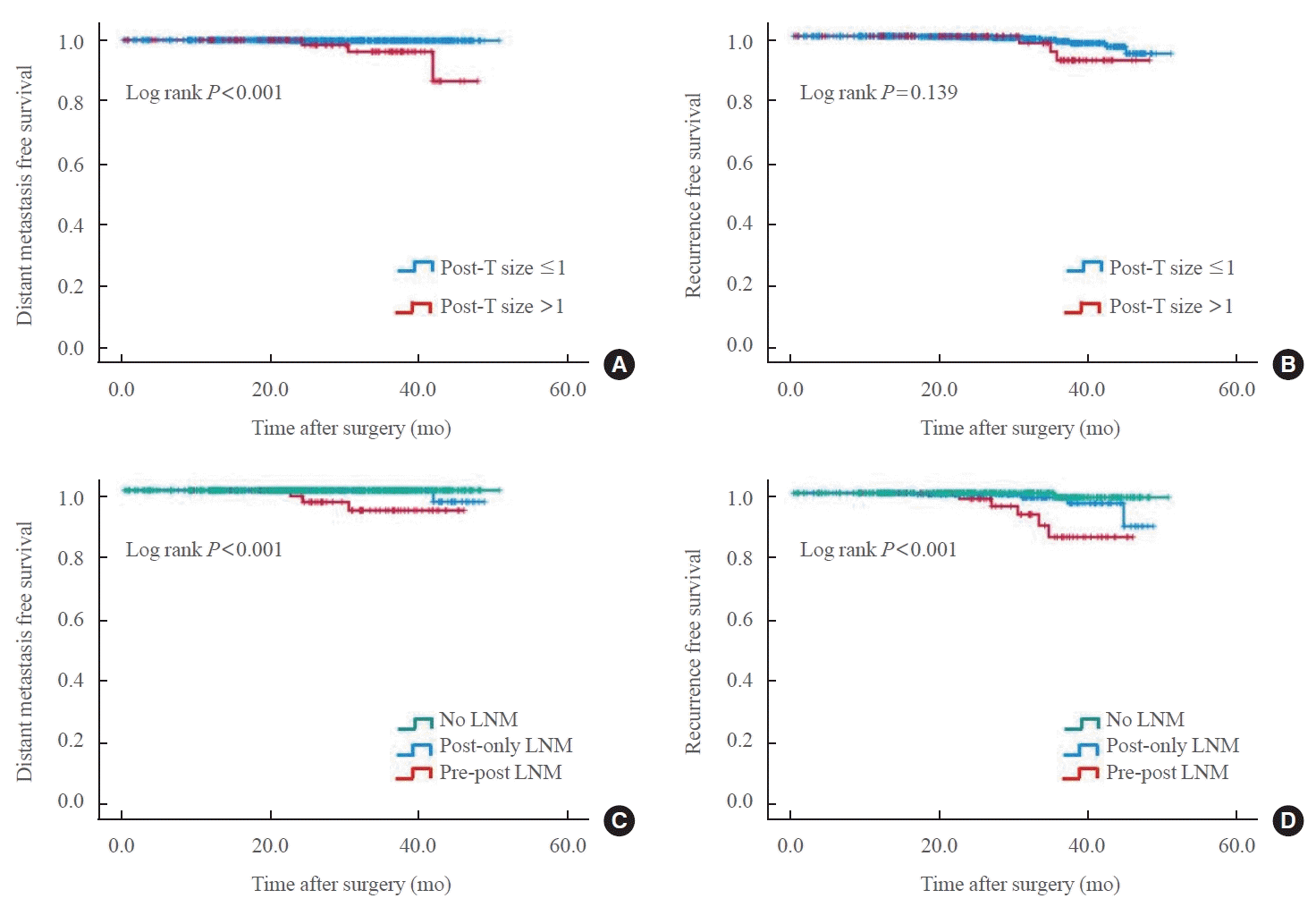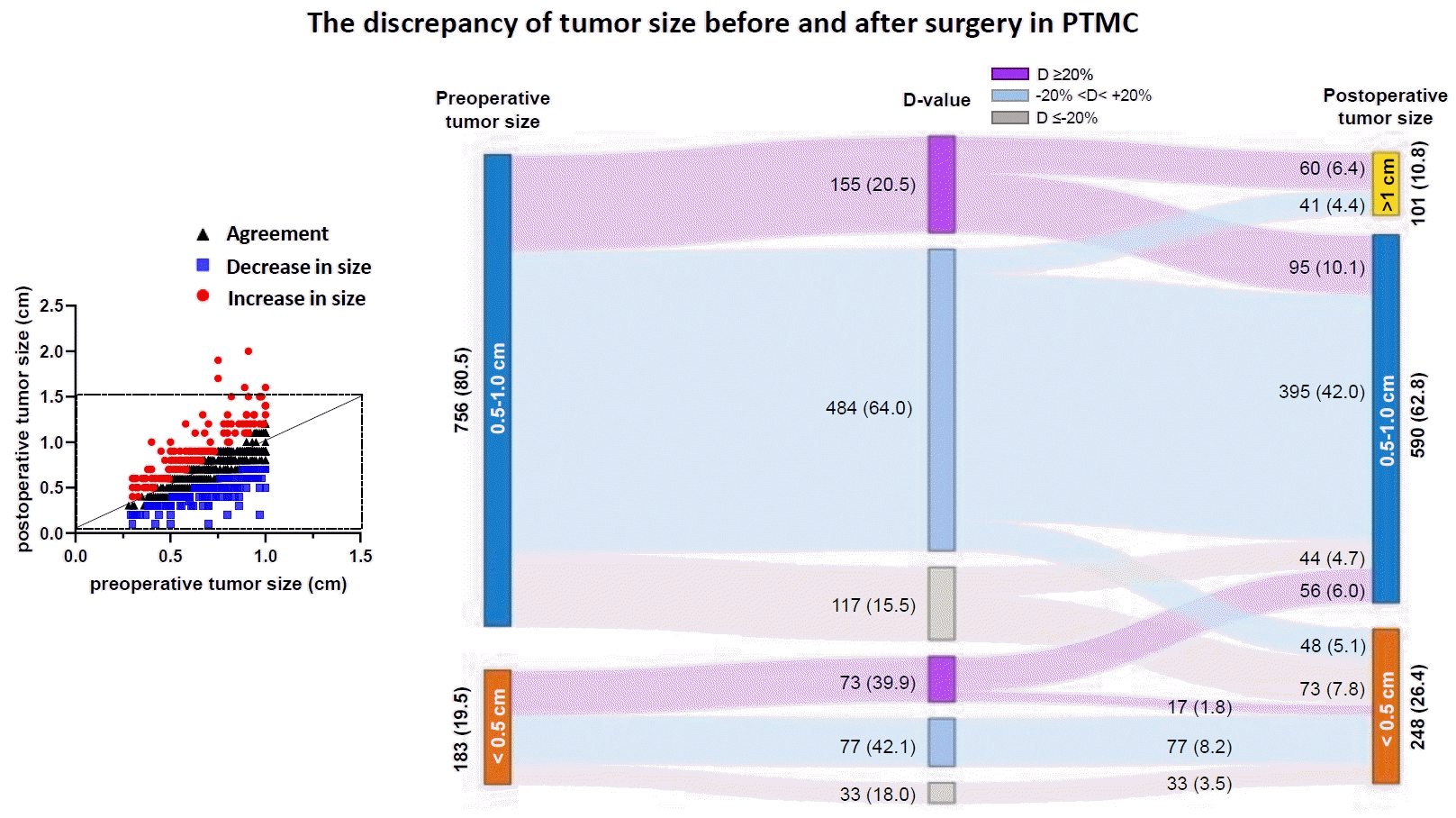Abstract
Background
Methods
Results
Supplementary Material
Supplemental Table S1.
Supplemental Table S2.
Supplemental Table S3.
Supplemental Fig. S1.
Notes
ACKNOWLEDGMENTS
REFERENCES
Fig. 1.

Fig. 2.

Fig. 3.

Table 1.
| Characteristic | Total | Low-risk | P value |
|---|---|---|---|
| Number of patients | 939 (100) | 738 (78.6) | |
| At diagnosis | |||
| Age, yr | 51.0±12.2 | 51.2±11.9 | 0.826 |
| Male sex | 194 (20.7) | 146 (19.8) | 0.657 |
| BMI, kg/m2 | 24.6±3.8 | 24.6±3.8 | 0.937 |
| Preoperative radiologic findings | |||
| Tumor size, cm | 0.70±0.19 | 0.69±0.19 | 0.803 |
| Radiologic LNM | 79 (8.4) | 0 | <0.00 |
| Surgical procedure | |||
| Total thyroidectomy | 438 (46.6) | 297 (40.2) | 0.009 |
| Central neck dissection | 838 (89.2) | 641 (86.9) | 0.133 |
| Lateral neck dissection | 62 (6.6) | 0 | <0.001 |
| Postoperative pathologic findings | |||
| Tumor size, cm | 0.72±0.25 | 0.71±0.25 | 0.459 |
| Multiplicity | 311 (33.1) | 236 (32.0) | 0.620 |
| ETE | |||
| Microscopic | 441 (47.1) | 327 (44.4) | 0.263 |
| Gross | 11 (1.2) | 9 (1.2) | 0.930 |
| LNM | 331 (35.3) | 211 (28.6) | 0.009 |
| LN size, mm | 2.5 (1.0–5.0) | 1.9 (1.0–3.0) | <0.001 |
| Ratio of LNM | 0.25 (0.17–0.46) | 0.29 (0.17–0.51) | 0.176 |
| BRAFV600E mutation | 838 (90.8) | 665 (91.5) | 0.630 |
| RAIT | |||
| Number of patients | 203 (21.6) | 109 (14.8) | <0.001 |
| Frequency of RAIT | 1 (1–2) | 1 (1–2) | 0.250 |
| Total cumulative dose, mCi | 60 (50–100) | 50 (50–80) | 0.037 |
| Complete ablation | 201 (99.0) | 109 (100.0) | 0.544 |
| Abnormal uptakea | 13 (6.4) | 5 (4.6) | 0.512 |
| Outcome | |||
| Distant metastasisb | 4 (0.4) | 1 (0.1) | 0.392 |
| Recurrence/persistence | 12 (1.3) | 4 (0.5) | 0.124 |
Values are expressed as number (%), mean±standard deviation, or median (interquartile range).
PTMC, papillary thyroid microcarcinoma; BMI, body mass index; LNM, lymph node metastasis; ETE, extrathyroidal extension; LN, lymph node; RAIT, radioactive iodine therapy.
Table 2.
| Group | Criteria |
Tumor size on radiology |
Total | P value | |
|---|---|---|---|---|---|
| 0–0.5 cm | 0.5–1.0 cm | ||||
| Agreement | –20% to 20%a | 77 (42.1) | 484 (64.0) | 561 (59.7) | <0.001 |
| Disagreement | |||||
| Decrease in size | ≤–20% | 33 (18.0) | 117 (15.5) | 150 (16.0) | 0.034 |
| Increase in size | ≥20% | 73 (39.9) | 155 (20.5) | 228 (24.3) | |
| Total | 183 (19.5) | 756 (80.5) | |||
Table 3.
| Characteristic | Post-T size ≤1 cm | Post-T size >1 cm | P value |
|---|---|---|---|
| Number of patients | 838 (89.2) | 101 (10.8) | |
| At diagnosis | |||
| Age, yr | 50.8±12.1 | 52.8±13.1 | 0.127 |
| Male sex | 173 (20.6) | 21 (20.8) | 0.972 |
| BMI, kg/m2 | 24.5±3.7 | 25.8±4.5 | 0.001 |
| Preoperative radiologic findings | |||
| Tumor size, cm | 0.67±0.18 | 0.93±0.10 | <0.001 |
| Radiologic LNM | 68 (8.1) | 11 (10.9) | 0.342 |
| Surgical procedure | |||
| Total thyroidectomy | 373 (44.5) | 65 (64.4) | <0.001 |
| Central neck dissection | 742 (88.5) | 96 (95.0) | 0.046 |
| Lateral neck dissection | 52 (6.2) | 10 (9.9) | 0.158 |
| Postoperative pathologic findings | |||
| Tumor size, cm | 0.66±0.19 | 1.20±0.17 | <0.001 |
| Multiplicity | 261 (31.1) | 50 (49.5) | <0.001 |
| ETE | |||
| Microscopic | 365 (43.7) | 76 (75.2) | <0.001 |
| Gross | 8 (1.0) | 3 (3.0) | 0.105 |
| LNM | 284 (38.4) | 47 (49.0) | 0.046 |
| LN size, mm | 2.2 (1.0–5.0) | 3.0 (1.3–5.5) | 0.262 |
| Ratio of LNM | 0.25 (0.17–0.50) | 0.28 (0.17–0.38) | 0.658 |
| BRAFV600E mutation | 748 (90.7) | 90 (91.8) | 0.705 |
| RAIT | |||
| Number of patients | 161 (19.2) | 42 (41.6) | <0.001 |
| Frequency of RAIT | 1 (1–2) | 2 (1–2) | 0.023 |
| Total cumulative dose, mCi | 60 (50–100) | 60 (50–80) | 0.687 |
| Complete ablation | 160 (99.4) | 41 (97.6) | 0.372 |
| Abnormal uptakea | 9 (5.6) | 4 (9.5) | 0.476 |
| Outcome | |||
| Distant metastasisb | 1 (0.1) | 3 (3.0) | 0.004 |
| Recurrence/persistence | 9 (1.1) | 3 (3.0) | 0.130 |
Values are expressed as number (%), mean±standard deviation, or median (interquartile range).
Post-T, postoperative tumor; BMI, body mass index; LNM, lymph node metastasis; ETE, extrathyroidal extension; LN, lymph node; RAIT, radioactive iodine therapy.
Table 4.
| Characteristic | Pre-post LNM | Post-only LNM | P value |
|---|---|---|---|
| Number of patients | 72 | 259 | |
| At diagnosis | |||
| Age, yr | 50.5±13.1 | 48.3±12.3 | 0.183 |
| Male sex | 27 (37.5) | 65 (25.1) | 0.038 |
| BMI, kg/m2 | 24.5±3.5 | 24.4±3.5 | 0.891 |
| Preoperative radiologic findings | |||
| Tumor size, cm | 0.71±0.20 | 0.71±0.19 | 0.819 |
| Radiologic LNM | 72 (100.0) | 0 | <0.001 |
| Surgical procedure | |||
| Total thyroidectomy | 68 (94.4) | 180 (69.5) | <0.001 |
| Central neck dissection | 72 (100.0) | 259 (100.0) | NA |
| Lateral neck dissection | 54 (75.0) | 5 (1.9) | <0.001 |
| Postoperative pathologic findings | |||
| Tumor size, cm | 0.77±0.25 | 0.75±0.25 | 0.661 |
| Multiplicity | 31 (43.1) | 102 (39.4) | 0.574 |
| ETE | |||
| Microscopic | 47 (65.3) | 158 (61.2) | 0.532 |
| Gross | 1 (1.4) | 4 (1.5) | 1.000 |
| LNM | |||
| LN size, mm | 8.0 (5.0–11.0) | 2.0 (1.0–3.0) | <0.001 |
| Micrometastasis | 6 (8.3) | 140 (56.7) | <0.001 |
| Ratio of LNM | 0.21 (0.15–0.35) | 0.26 (0.17–0.50) | 0.019 |
| BRAFV600E mutation | 64 (88.9) | 239 (93.4) | 0.207 |
| RAIT | |||
| Number of patients | 58 (80.6) | 119 (45.9) | <0.001 |
| Frequency of RAIT | 2 (1–2) | 1 (1–2) | 0.288 |
| Total cumulative dose, mCi | 100 (57.5–100) | 60 (50–80) | <0.001 |
| Complete ablation | 56 (96.6) | 119 (100.0) | 0.106 |
| Abnormal uptakea | 7 (12.1) | 6 (5.0) | 0.124 |
| Outcome | |||
| Distant metastasisb | 3 (4.2) | 1 (0.4) | 0.034 |
| Recurrence/persistence | 5 (6.9) | 4 (1.5) | 0.026 |
Values are expressed as mean±standard deviation, number (%), or median (interquartile range).
LNM, lymph node metastasis; BMI, body mass index; NA, not available; ETE, extrathyroidal extension; LN, lymph node; RAIT, radioactive iodine therapy.




 PDF
PDF Citation
Citation Print
Print




 XML Download
XML Download